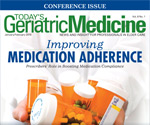 |
A recent study has found that among patients in hospice care, nursing home residents were older, more likely to be women, more likely to be on both Medicare and Medicaid, and more likely to have dementia than were individuals receiving hospice services outside of nursing homes. Findings indicate that nursing home patients have longer hospice stays than counterparts in hospice care in the community.
Increasing costs, longer hospice stays, and concerns about duplication of services have prompted policymakers to study the delivery of hospice care services.
In addition to reading our e-newsletter, be sure to visit Today’s Geriatric Medicine’s website at www.TodaysGeriatricMedicine.com, where you’ll find news and information that’s relevant and reliable. We welcome your feedback at TGMeditor@gvpub.com. Follow Today’s Geriatric Medicine on Facebook and Twitter, too.
— Barbara Worthington, editor |
 |
 |
Study Assesses Hospice Use
As hospice for nursing home patients grows dramatically, a new study from the Regenstrief Institute and the Indiana University Center for Aging compares the characteristics of hospice patients in nursing homes with hospice patients living in the community. The study provides details on how hospice patients move in and out of these two settings.
Longer stays in hospice care, rising costs, and concerns over possible duplication of services have led to increased policymakers’ scrutiny of hospice patients living in nursing homes. Nursing home patients have longer hospice stays compared with individuals living in the community.
The researchers, led by Regenstrief Institute investigator and IU Center for Aging Research scientist Kathleen Unroe, MD, MHA, found that nursing home hospice patients were older, more likely to be women, more likely to be on both Medicare and Medicaid, and more likely to have dementia than individuals receiving hospice services outside a nursing home.
Full story » |
 |
 |
Pain Management Strategies
Providers must take steps to identify the type and source of patients' pain and provide the most appropriate form of treatment. Read more »
Interventions Slow Brain Atrophy
Specialized interventions can maximize cognitively impaired patients' ability to control cognitive and functional demands to the greatest possible extent. Read more »
Gait Speed Reflects Cognitive Function
Gait speed, recognized as a vital sign in older adults, is a screening measure reflective of both physical and cognitive function. Read more » |
 |
|
|
 |
|
|
 |
 |
ResidentGuard LS 2400
Accutech Security has released its new ResidentGuard LS 2400 wander management system, which can be used in older adult residential community settings. The LS 2400 system, a low-cost wander system, provides resident ID, loiter and door-ajar monitoring, low tag battery, and several more alerts without the need for a computer. It can provide resident identification and reporting at the door or at a nurses’ station with optional LCD displays. Other functions include on-screen reporting and the ability to configure multiple zones from a single display. It uses a wider RF range, minimizing the need for an extra antenna for double door applications. Learn more »
SENSUS Pain Management System
NeuroMetrix has created the SENSUS Pain Management System, a wearable neurostimulation technology developed for chronic neuropathic pain, including painful diabetic neuropathy. The noninvasive device, worn on the leg just below the knee, is operated by pressing a button that triggers the device to stimulate sensory nerves in the leg during a 60-minute session. It can reduce pain signal transmission through the central nervous system, according to the company. Lightweight and low profile, it can be worn under clothing, providing pain relief by stimulating the nerves that carry normal nonpainful sensations to the brain, changing the levels of certain natural chemicals in the nervous system that decrease pain. Learn more » |
 |
 |
 |
A Secure, Anonymous Résumé Bank
Job Alerts Sent to Your E-mail |
 |
|


